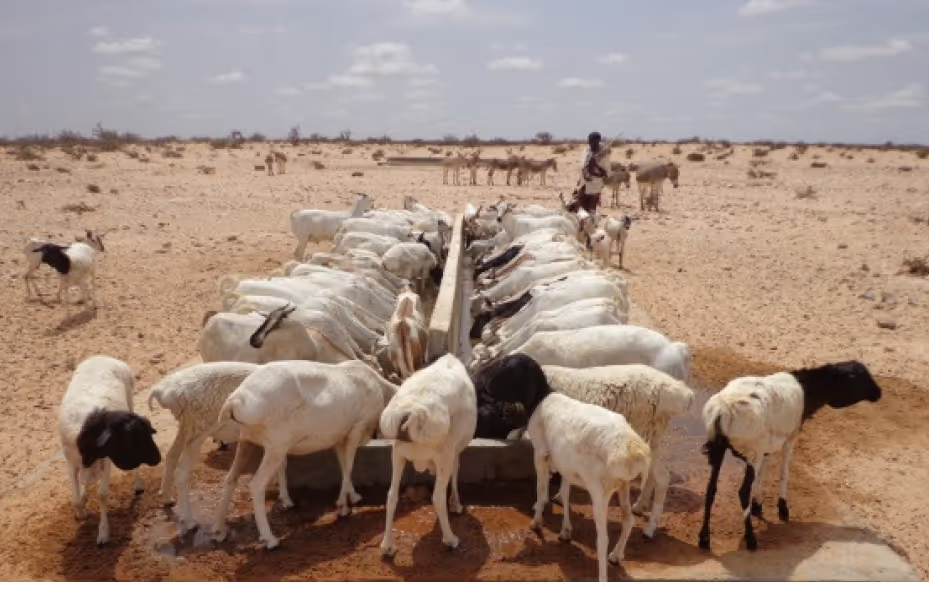Drought insurance to enable timely humanitarian response

Project overview
Project solution
This project offers [specific solution or intervention] to tackle [challenge]. By implementing [strategies, tools, or innovations], the project aims to achieve [desired outcomes]. The approach is designed to [specific actions or methods] to bring about meaningful change in [community, region, or issue area].
Expected outcomes
This project aims to achieve [specific outcomes], such as [measurable results, improvements, or changes]. The expected impact includes [benefits to the target community, advancements in research or innovation, or long-term effects]. By the end of the project, we anticipate [specific changes or milestones] that will contribute to [broader goals or objectives].
The Start Network and GobalAgRisk are developing a drought insurance product which will enable automatic pay-outs for early civil-society response to major food crises. Insurance will be tied to a predictive, early warning index of evolving drought conditions which will be monitored by a third party. Pay-outs will be made when pre-agreed triggers are met. Pay-outs will be allocated to NGOs and their civil society partners according to agreed protocols that channel funding to those best placed to respond.
What is the humanitarian need?
Despite widespread advances in early warning systems for major droughts, the ability of NGOs to respond early to prevent these crises from happening is constrained by the current funding model. Even when a known major food crisis is unfolding, funds often do not materialise until media headlines hit international audiences and donors are prompted into action. At this stage many lives have already been lost, livelihoods destroyed and hard-won development gains undermined. Early, preventative action in such situations has been found to be far more effective, but this requires access to predictable funding.
What is the innovative solution?
A parametric insurance product would enable predictable and impartial early funding to mount preventative actions when they are most needed in countries vulnerable to acute slow-onset drought.
This project is at invention stage. The partners will be doing a feasibility assessment to conceptualise and lay-out the basic components needed for a prototype parametric insurance product for 20 pilot countries.
How does the innovation build on and improve existing humanitarian practice?
This approach uses commercial principles of risk management and risk pooling, and applies them in a new way to the humanitarian context. It does this by building on advances in early warning and forecasting systems.
This mechanism will also aim to complement and reinforce best practice in the areas of inter-agency contingency planning and early action in food crises through the design of the protocols for pay-outs. The innovation will enhance funding certainty and predictability to support more effective and principled humanitarian action.
What are the expected outputs?
Key outputs will include the following:
- Prototype model to demonstrate the working principles of the parametric insurance mechanism
- Matrix identifying selection of the drought-prone countries to be included in the risk transfer portfolio
- Protocol outlined for how the pay-outs would be allocated, reinforcing best practice in early action
- Map of implementation pathways (identification of index and third-party monitoring, options for payment of premiums, likely challenges to be overcome)
Summary
The Start Network and GobalAgRisk are developing a drought insurance product which will enable automatic pay-outs for early civil-society response to major food crises.
Insurance will be tied to a predictive, early warning index of evolving drought conditions which will be monitored by a third party. Pay-outs will be made when pre-agreed triggers are met. Pay-outs will be allocated to NGOs and their civil society partners according to agreed protocols that channel funding to those best placed to respond.
What humanitarian need is being addressed?
Despite widespread advances in early warning systems for major droughts, the ability of NGOs to respond early to prevent these crises from happening is constrained by the current funding model. Even when a known major food crisis is unfolding, funds often do not materialise until media headlines hit international audiences and donors are prompted into action. At this stage many lives have already been lost, livelihoods destroyed and hard-won development gains undermined. Early, preventative action in such situations has been found to be far more effective, but this requires access to predictable funding.
What is the innovative solution?
A parametric insurance product would enable predictable and impartial early funding to mount preventative actions when they are most needed in countries vulnerable to acute slow-onset drought.
This project is at invention stage. The partners will be doing a feasibility assessment to conceptualise and lay-out the basic components needed for a prototype parametric insurance product for 20 pilot countries.
;
How does the innovation build on and improve existing humanitarian practice?
This approach uses commercial principles of risk management and risk pooling, and applies them in a new way to the humanitarian context. It does this by building on advances in early warning and forecasting systems.
This mechanism will also aim to complement and reinforce best practice in the areas of inter-agency contingency planning and early action in food crises through the design of the protocols for pay-outs. The innovation will enhance funding certainty and predictability to support more effective and principled humanitarian action.
What materials or research outputs are likely to be produced?
Key outputs will include the following:
- Prototype model to demonstrate the working principles of the parametric insurance mechanism
- Matrix identifying selection of the drought-prone countries to be included in the risk transfer portfolio
- Protocol outlined for how the pay-outs would be allocated, reinforcing best practice in early action
- Map of implementation pathways (identification of index and third-party monitoring, options for payment of premiums, likely challenges to be overcome)
Project delivery & updates
Stay up to date with the latest developments from this project. Here, you will find details on what has been delivered, resources created, and regular updates as the project progresses. Access key documents, reports, and other materials to see how the project is making an impact.